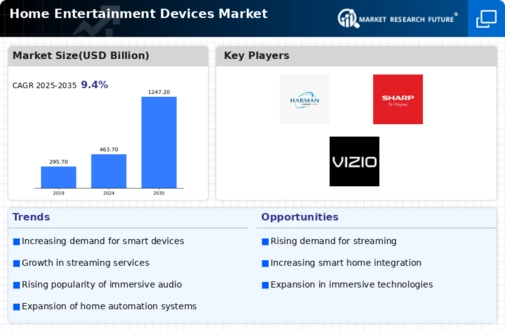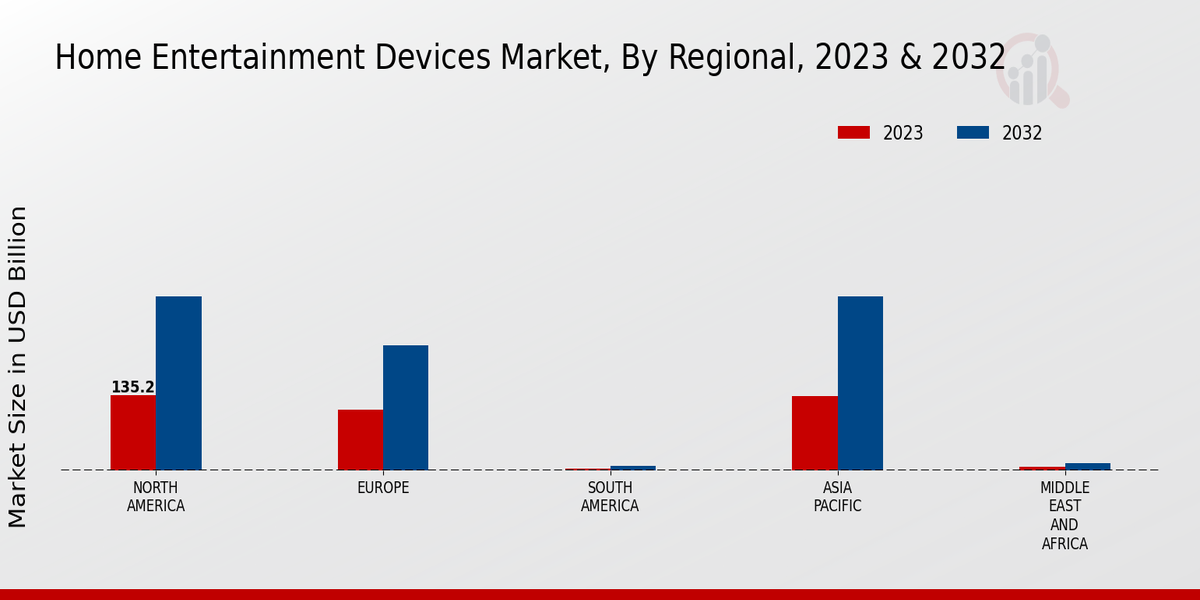Home Automation Trends
The rise of home automation is reshaping the Global Home Entertainment Devices Market Industry, as consumers increasingly integrate entertainment systems into their smart home ecosystems. Devices that offer compatibility with home automation platforms, such as Amazon Alexa and Google Assistant, are gaining traction. This trend not only enhances user convenience but also elevates the overall entertainment experience. As the market evolves, the demand for interconnected devices is expected to grow, contributing to the projected market value of 1247.2 USD Billion by 2035. The synergy between home automation and entertainment devices suggests a promising future for manufacturers who can innovate in this space.
Rising Disposable Income
An increase in disposable income globally appears to be a significant driver for the Global Home Entertainment Devices Market Industry. As consumers have more financial flexibility, they are more inclined to invest in premium home entertainment systems. This trend is particularly evident in emerging markets, where rising middle-class populations are seeking enhanced entertainment experiences. The market's projected growth to 1247.2 USD Billion by 2035 indicates that this trend may continue, as consumers increasingly prioritize home entertainment as a vital aspect of their lifestyle. Consequently, the demand for high-end audio and visual equipment is likely to rise, further propelling market growth.
Market Growth Projections
The Global Home Entertainment Devices Market Industry is poised for substantial growth, with projections indicating a market value of 463.7 USD Billion in 2024 and an anticipated increase to 1247.2 USD Billion by 2035. This growth trajectory suggests a robust compound annual growth rate (CAGR) of 9.41% from 2025 to 2035. Such figures reflect the increasing consumer demand for advanced home entertainment solutions, driven by technological innovations and changing viewing habits. The market's expansion is likely to be influenced by factors such as rising disposable income, the growth of streaming services, and the integration of smart technologies.
Technological Advancements
The Global Home Entertainment Devices Market Industry is experiencing rapid growth driven by continuous technological advancements. Innovations in display technologies, such as OLED and 8K resolution, enhance the viewing experience, attracting consumers. Additionally, the integration of smart technologies enables seamless connectivity and control through mobile devices. As of 2024, the market is valued at 463.7 USD Billion, reflecting a strong consumer demand for high-quality entertainment solutions. The proliferation of streaming services further fuels this growth, as consumers seek devices that can support high-definition content. This trend suggests that ongoing technological improvements will likely sustain the industry's expansion.
Growth of Streaming Services
The proliferation of streaming services has transformed consumer behavior, significantly impacting the Global Home Entertainment Devices Market Industry. With platforms like Netflix, Amazon Prime, and Disney+ gaining immense popularity, consumers are increasingly seeking devices that can deliver high-quality streaming experiences. This shift has led to a surge in demand for smart TVs and streaming devices, which are designed to optimize content delivery. As the market evolves, it is projected to grow at a CAGR of 9.41% from 2025 to 2035, indicating that the appetite for streaming-compatible devices will likely continue to drive market expansion. This trend underscores the importance of adaptability in product offerings.
Consumer Preference for Personalization
Consumer preferences are shifting towards personalized entertainment experiences, which is a notable driver in the Global Home Entertainment Devices Market Industry. As individuals seek tailored content and experiences, manufacturers are responding by developing devices that offer customizable features. This trend is particularly evident in sound systems and smart TVs, where users can adjust settings to suit their preferences. The anticipated growth of the market to 1247.2 USD Billion by 2035 indicates that personalization will likely remain a key focus for consumers. This evolving landscape suggests that companies must prioritize user-centric design to meet the demands of a diverse consumer base.





